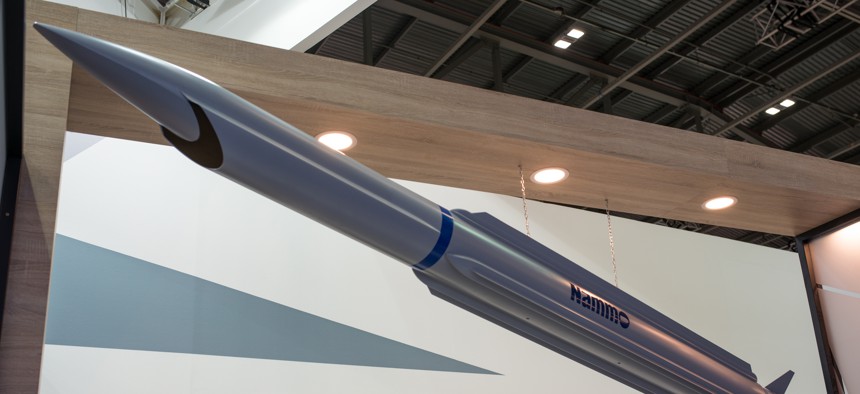
NAMMO's model of a proposed ramjet-powered SAM NAMMO
An Old Idea Could Bring Anti-Aircraft Missiles of Unprecedented Capability
Ramjet SAMs promise interceptions at altitudes and distances far beyond today’s defenses.
LONDON — Surface-to-air missiles with ramjet sustainer engines might be poised for a comeback.
Such engines were central to European, Soviet and United States medium-to-long-range SAM system research and development in the 1950s and 1960s, but today only a handful of the Soviet-era 2K11 Krug (SA-4 Ganef) and 2K12 Kub (SA-6 Gainful) remain in service. Nammo would like to change that.
The Norwegian energetics and propulsion specialist is developing a ramjet engine that it believes could power an extended-range SAM, offering an engagement capability far beyond most of today’s Western systems. The company claims a range envelope beyond 400 kilometres (250 miles) for high-altitude fly-out, although a Nammo official acknowledged the difficulties in targeting aircraft so far away.
Ramjet engines differ from solid-propellant motors in that they scoop up atmospheric oxygen as they fly, rather than carrying it from the ground as part of a solid motor. (They do require a solid booster to accelerate them to speeds where ramjet combustion is able to be sustained efficiently. Nammo’s design uses an integrated solid booster to make the transition around Mach 3, then cruise at Mach 3.5 at altitudes between 15.2 and 18.3 km (9.5 and 11.4 miles). But overall, a ramjet-sustainer missile can carry more fuel than a solid-propellant missile of the same size, and so fly farther and faster. A ramjet-powered SAM could be used against comparatively fast high-altitude targets while still under power, at ranges at which solid-propellant missiles would be burned out and rapidly losing energy.
Earlier this month, Nammo showed a concept model of a ramjet-powered SAM at the recent Defence and Security Equipment International exhibition here. The design showed a chin-mounted intake below a reduced-diameter forward section and narrow-chord wings. Two of the missile’s four strakes that extend along the length of the body act as bypass ducts, and by varying the air flow can be used to throttle the engine.
Related: Some Cautionary Notes on the New ‘Knife Missile’
Related: Fighter Jets with Missile-Killing Lasers Take Another Step Toward Reality
Related: Nuclear-Powered Cruise Missiles Are a Terrible Idea. Russia’s Test Explosion Shows Why
The entire missile is designed to fit into the launch canister of the National Advanced Surface-to-Air Missile Systems, or NASAMS. Operated by Norway, Finland, and the Netherlands, NASAMS uses a variant of the AIM-120 Advanced Medium-Range Air-to-Air Missile developed by Raytheon and powered by a Nammo solid-fuel motor. The company is working with Norway’s Kongsberg Defence and Aerospace on NASAMS and the upgraded NASAMS II.
The company is working toward an initial ground test-launch of the ramjet sustainer by 2022 or 2023.
Nammo is now looking for possible partners who might be interested in using its ramjet motor as the basis for a SAM or perhaps an extended-range air-to-air missile, like the rocket/ramjet Meteor made by European missile manufacturer MBDA and operated by Sweden and the United Kingdom.
And in June, the company agreed to team up with Boeing Defense, Space and Security to develop a ramjet-boosted artillery round. Dubbed HE-ExR, for High-Explosive Extreme Range, it has a projected range of up to 150 km (93 miles). Live-fire tests are due to begin next year.
Whether or not Nammo’s SAM ramjet goals are met remains to be seen. What is clear, however, is that renewed interest and investment in high-speed guided-weaponry is going to see the wider adoption of ramjet and scramjet (supersonic-combustion ramjet) engine technology in both offensive and defensive roles.